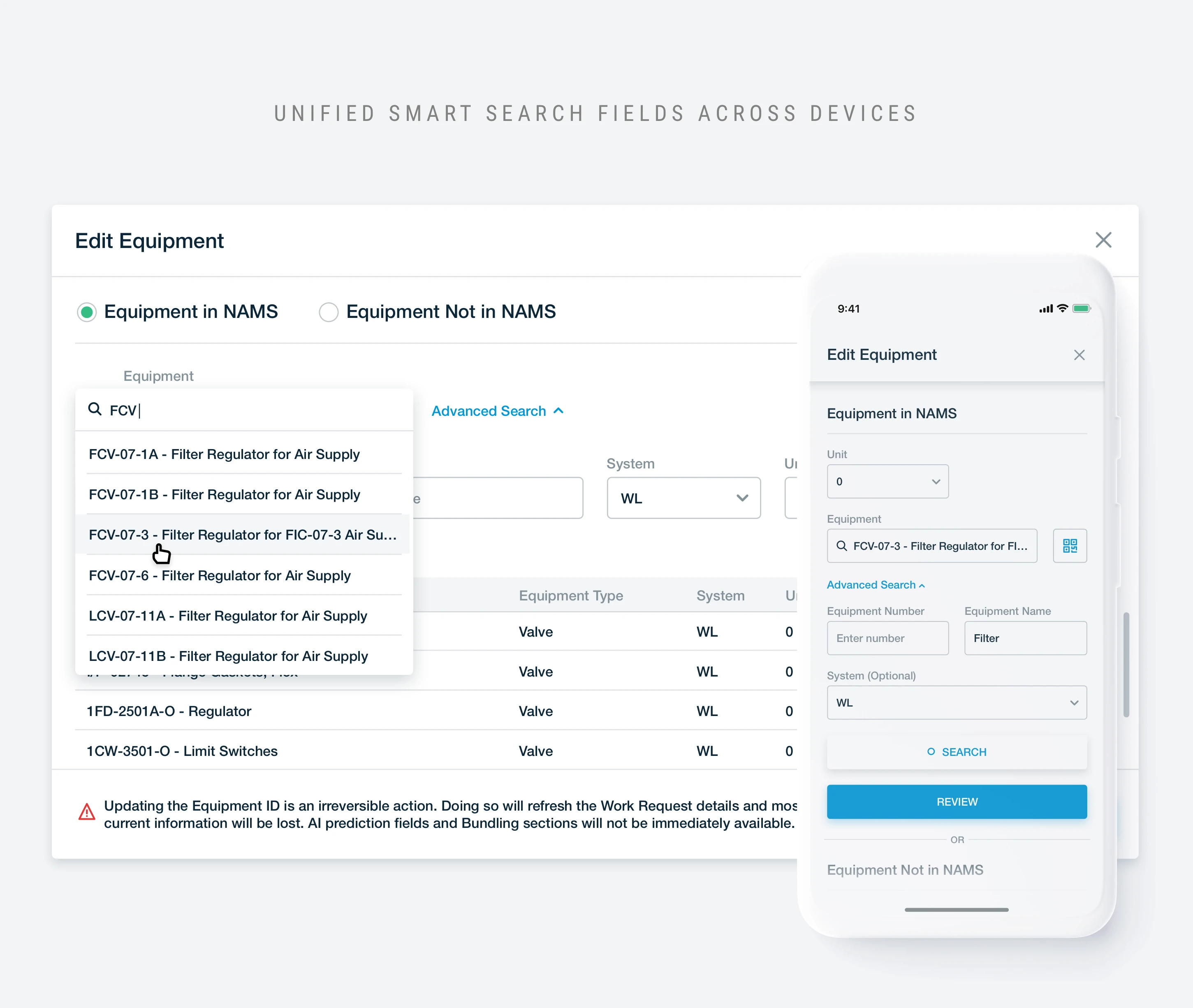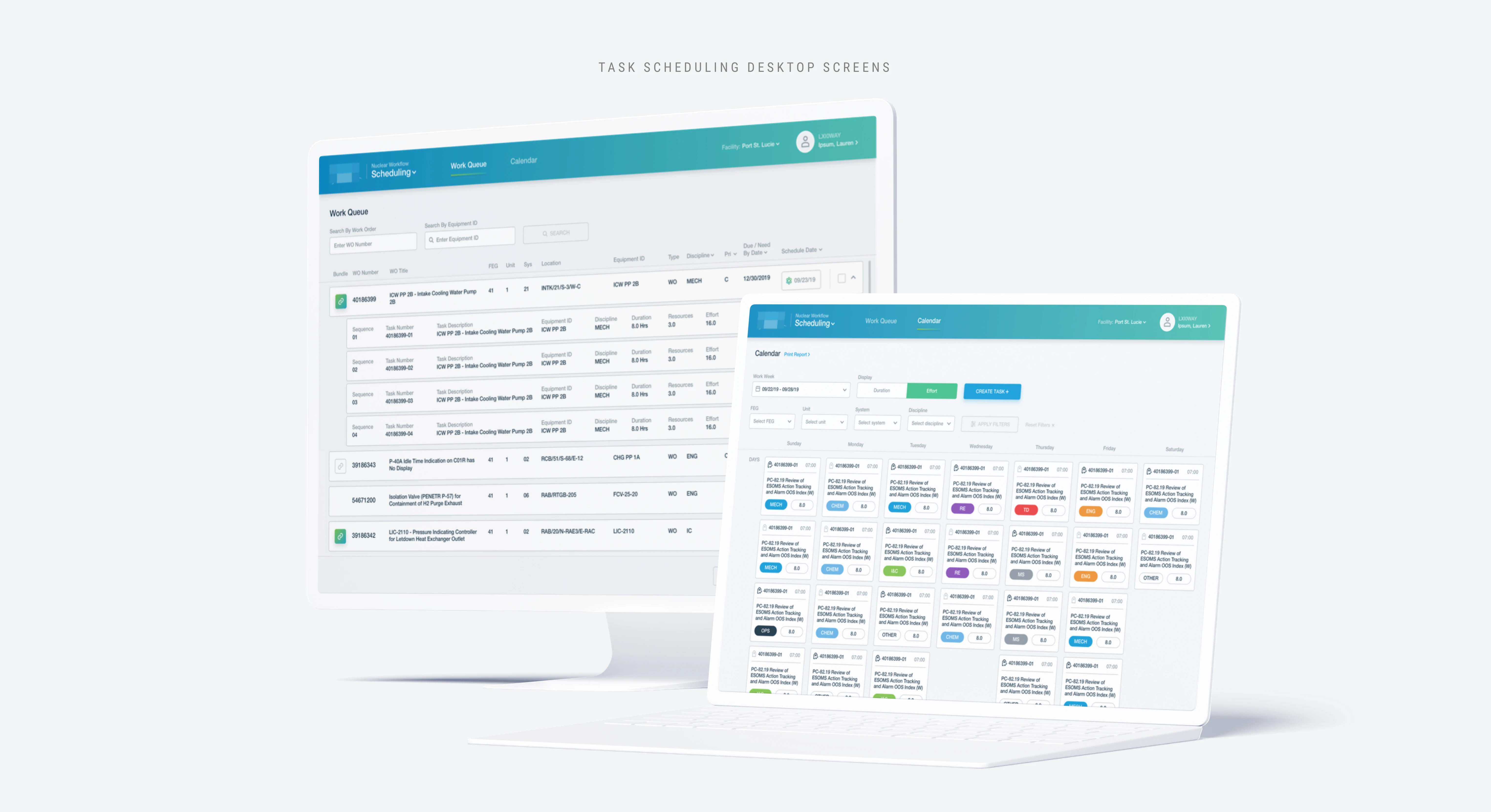Energy Company
With one of the largest technically and regulatorily demanding operations in the country, this (undisclosed) Energy Client needed to bridge and transform dozens of legacy safety and maintenance management systems for their nuclear power plants.
Embedded for a massive 16-month umbrella project, our team at Levatas helped defined dozens of user roles and core personas, new possibilities and efficiencies with AI-enabled solutions, a wide-and-deep design system to unify experiences across the entire fleet, a new brand for the suite of style guides and component libraries, and hundreds of screens of design.
Final project outputs include branding, UX & UI for multiple apps, and a full design system.
Design System: Rebuilt Atoms
The digital systems at power plants are old, and during the discovery process our team found even the most digital design principles — consistent form fields, responsive layouts, and working search bars — were missing from most screens.
With four core applications across dozens of user roles and many users switching betweens apps regularly, our team began by the UI process by rebuilding those core visual elements from the ground up.
Detailed user interviews with multiple teams in the discovery phase allowed us to identify the needs of those foundational forms, CTA’s, and layouts that would support screens a dozen sprints away.
Form Field Structure
Users spent most of their time in cumbersome Windows 95 style legacy databases that often had unique and confusing restrictions or functionality that were added ad-hoc over time. The experience was ugly, but more importantly inconsistent and offered poor feedback.
Our team focused on building forms, tables, and smart searches from the ground up to cover the varied functionality across systems in a consistent user experience that was ADA compliant.
AI Predicted Data
A core deliverable across applications were several AI-driven data models that would aid users decision making and allow employees to spend less time on routine cases and more time on challenging cases.
Working with users and data scientists over several sprints, we refined the best UX approach to displaying AI selections that still empowered users to override the data model using their expertise.
Unified Item Search
Despite various systems depending on reliable equipment data to track every item at the power plant, they had no way of reliably searching or ID’ing the correct item.
Aside from unifiying various databases to centralize the data, Equipment Search (and later search for parts, inventory, and more) required a smarter and unified modal system that could live across applications and devices.
Just as important as building the foundation for the applications was documenting the styles, components, and usage of the core elements. Our team constantly updated our style guides and explainers in Invision and Zeplin after every sprint, and often released new documentation with feature launch meetings that allowed executives and implementers across departments to give input and gain insights.
Core Persona’s & Apps
As we audited the current systems and built the design system foundation, our team worked to identify the persona’s who interacted with these various applications through hundreds of user interviews with fleet employees and contractors across the country. From those interviews we found which systems needed the most work, which could be condensed, and which solutions offered immediate relief for the users and the best ROI for the company in the long-term.
Importantly these users and their persona’s drove the UX and UI throughout the process, including during development cycles and after in user testing. When building apps that literally keep nuclear reactors safe, keeping SME’s close to every part of the develop cycle was paramount for our success.
Our team spent multiple sprints focused on wireframes for hundreds of screens, which changed and improved on weeks of user testing and SME input. Eventually these wireframes boiled down to four core app journeys primed for high fidelity design.
Work Identification App
At the beginning of any ticketing system is identification. On “Work ID,” we transformed an analog paper-to-pen-to-data-entry approach and modernized it for their fleet.
Whether on their phone, iPad, or desktop, any field employee that finds something wrong on the plant can easily search for the item based on name, bar code, or location and effectively report the error with photographs to aid downstream security and maintenance teams.
By the end the Work ID phase (26 two-week sprints), we had created more than 20 user journeys, over 100 unique screens across four device breakpoints (Desktop, Legacy Desktop, Tablet, Mobile).
Task Screening App
After tickets are generated, ID’ing equipment, rushing impactful tickets to the top, cleaning data, analyzing requests and condensing duplicates is a vital step in running a power plant.
What used to be a printed PDF and a meeting of multiple skilled employees transformed into a smarter, AI-driven and predictive system to rise the important tasks to top while automating mundane data clean up.
Screening Work Queue
Our team worked closely with users to reimagine a daily meeting (featuring a 100+ page printed document of hand entered tasks) into a digital work queue. Multiple personas ended up benefitting from this queue view, and as we tested the app with more users additional use cases found their way into the app.
On the backend, AI models analyzing the large historical record of tasks allowed us to suggest changes and adjustments to tickets.
AI Feedback
It was vital for screeners — some of the most highly trained and senior employees on a power plant floor — to be able to not only receive AI suggestions but also overwrite them.
Throughout the engagement, our team refined how AI suggestions we're displayed and how easy they were for users to change. When the expert users made changes to the AI suggestions, the app captured feedback from users in real time to feed back into the model for improvement.
Reducing Redundant Work
In the fog of user interviews, our team found a consistent time waster was duplicate work. When an item at the power plant has an issue, there were often multiple individual tickets generated from different employees or departments. In the old manual process, sorting through these duplicates was messy and time consuming.
In the Task Screening Queue, our team created a way to bundle duplicate tasks and take the best information from each ticket. In addition to AI-driven bundling, users could create their own — with that data fed right back into the AI models to improve it's ability to identify duplicates.
Task Scheduling App
A brand new unified Work Queue allowed users to easily connect tasks and subtasks (used to require two separate applications), re-order those tasks based on team availability, and deploy bundled work to keep teams working efficiently throughout the plant.
The Calendar view allows managers to keep teams booked and scheduled to budget for this week, next week, and next year — all with quick batched scheduling and drag-and-drop calendar cards.
In the scheduling phase our team produced two core tabs for separate persona’s, with multiple user journeys for each, across over 30 unique screens.




















